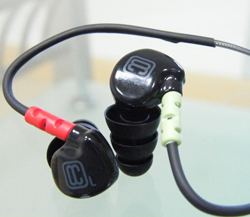In-ear monitors (IEMs) are radically different from the traditional floor wedge method of providing a monitor mix to performers.
For many artists and engineers, they are the ideal monitor solution. But for others, they’re simply a method of trading one set of problems (extreme volume, tiny sweet spot, feedback potential) for another (sense of isolation, can’t hear amps or audience).
Clever engineers and earphone manufacturers have come up with various methods of handling these issues, all of which revolve around how ambient sound is dealt with.
The goal of most professional earphones is isolation. Think of it in terms of signal-to-noise ratio. The intended signal (monitor mix) is pumped directly into the ear, while the undesirable noise (ambient sound) is shut out. The greater the isolation, the higher the S/N ratio.
Isolating earphones can typically achieve about 18-24 dB of isolation (with some custom designs achieving up to 37 dB). Without the competition from ambient noise on stage, the user can hear the monitor mix with exceptional clarity at significantly lower volumes. This is the source of the hearing conservation claims typically mentioned as a selling point for in-ear systems.
But it’s up to the musician to take advantage of this new listening environment by reducing volume settings.
A Good Thing?
The very isolation that makes personal monitors effective can cause problems for performers. By eliminating ambient sound, IEM systems performers can no longer hear the acoustic output of instruments (drums, piano) and amplifiers, and the hopefully rapturous sound of the audience. And on-stage communication becomes impossible without removing an earpiece.
In fact, many artists have taken to performing with one earpiece in and the other out. In terms of hearing protection, this is the worst of all possible worlds. The in-ear mix is now competing with information from the open ear, requiring at least 6 dB of extra level to be as intelligible as it is with both earpieces inserted.
At the same time, the open ear is fully exposed to uncontrolled stage levels. But if one-in, one-out is unhealthy (and it is!), what’s an artist to do? There are several ways to approach this issue, ranging from clever and low-tech to sophisticated and high-tech. Let’s take a look.
Mics On The Crowd
To get crowd noise into the mix, many monitor engineers simply mic the audience and add it into the inear mix. Microphones can be set up on lighting trusses, out at the house mix position, or wherever.
Typically, these are turned down during songs and brought up in between, allowing the band to “connect” with the audience. This solution answers the issue of isolation from the fans, but has a couple disadvantages:
1) It puts an extra burden on the monitor engineer, who now has to “mix” the crowd microphones throughout the show, and eats up precious inputs at the monitor desk.
2) It’s impossible to mic an entire audience in a way that mimics what musicians would hear naturally. A stereo pair of microphones only retains natural direction cues if the artist is facing the right way, and even then the distance cues are wrong. In addition, using microphones on a crowd does not help to allow conversation on stage.
The Dave Matthews Band addressed that issue when they went to personal monitors. Monitor engineer Ian Kuhn put lavalier microphones on the performers to enable onstage communication between numbers.
Adding extra wireless channels just for that purpose is very gear-intensive, and certainly not economical. However, it does allow conversation within the band, something that Kuhn notes is critical to the band’s stage show.





















